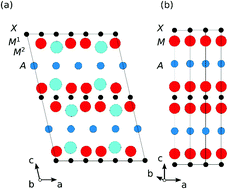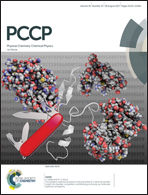An investigation of the in-plane chemically ordered atomic laminates (Mo2/3Sc1/3)2AlC and (Mo2/3Y1/3)2AlC from first principles
Abstract
We have calculated electronic, vibrational, and elastic properties of (Mo2/3Sc1/3)2AlC and (Mo2/3Y1/3)2AlC, two recently discovered nanolaminated materials in the family of so-called i-MAX phases. A comparison is made to the properties of the related hypothetical MAX phases Sc2AlC, Y2AlC, and Mo2AlC. From an analysis of the electronic band structures and projected crystal orbital Hamilton populations (pCOHP), we show that the i-MAX phases have more isotropic band structures than the MAX phases, but that their bonding characteristics are very similar, despite belonging to different space groups. However, the similar bonding notwithstanding, qualitative as well as significant quantitative differences are seen in the phonon density of states (PDOS). We also compare the Voigt–Reuss–Hill (VRH) bulk, shear, and Young's moduli. For (Mo2/3Sc1/3)2AlC, BVRH = 132 GPa, GVRH = 89 GPa, and EVRH = 218 GPa, all of which are higher values than for Sc2AlC, but lower than for Mo2AlC. For (Mo2/3Y1/3)2AlC, BVRH = 117 GPa, GVRH = 85 GPa, and EVRH = 205 GPa, which are higher than for Y2AlC, but lower than for Mo2AlC.



 Please wait while we load your content...
Please wait while we load your content...